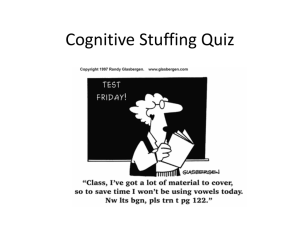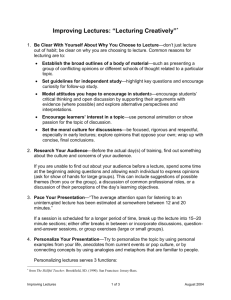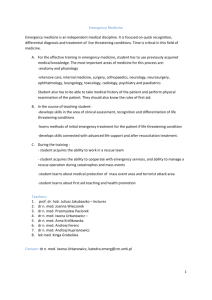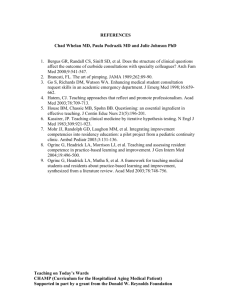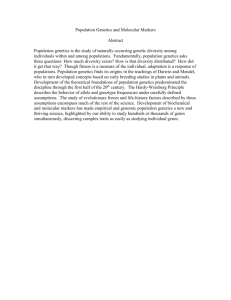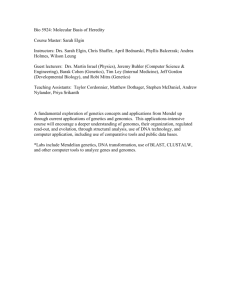Cognitive Stuffing / Bulimic Learning
advertisement
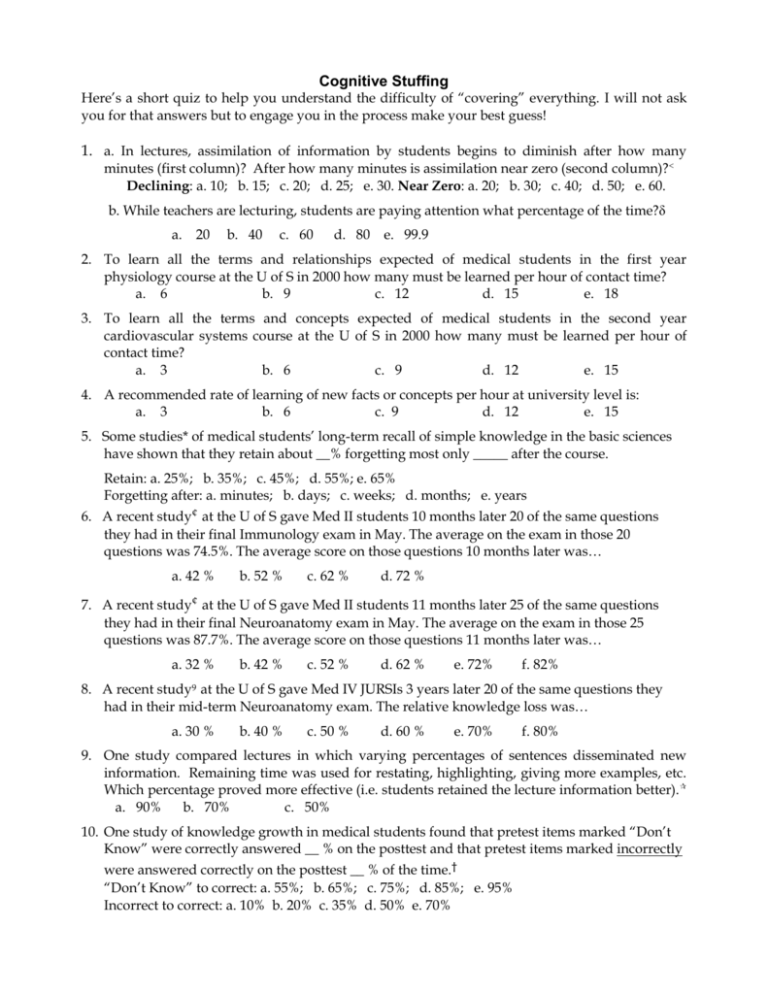
Cognitive Stuffing Here’s a short quiz to help you understand the difficulty of “covering” everything. I will not ask you for that answers but to engage you in the process make your best guess! 1. a. In lectures, assimilation of information by students begins to diminish after how many minutes (first column)? After how many minutes is assimilation near zero (second column)? Declining: a. 10; b. 15; c. 20; d. 25; e. 30. Near Zero: a. 20; b. 30; c. 40; d. 50; e. 60. b. While teachers are lecturing, students are paying attention what percentage of the time?δ a. 20 b. 40 c. 60 d. 80 e. 99.9 2. To learn all the terms and relationships expected of medical students in the first year physiology course at the U of S in 2000 how many must be learned per hour of contact time? a. 6 b. 9 c. 12 d. 15 e. 18 3. To learn all the terms and concepts expected of medical students in the second year cardiovascular systems course at the U of S in 2000 how many must be learned per hour of contact time? a. 3 b. 6 c. 9 d. 12 e. 15 4. A recommended rate of learning of new facts or concepts per hour at university level is: a. 3 b. 6 c. 9 d. 12 e. 15 5. Some studies* of medical students’ long-term recall of simple knowledge in the basic sciences have shown that they retain about __% forgetting most only _____ after the course. Retain: a. 25%; b. 35%; c. 45%; d. 55%; e. 65% Forgetting after: a. minutes; b. days; c. weeks; d. months; e. years 6. A recent study¢ at the U of S gave Med II students 10 months later 20 of the same questions they had in their final Immunology exam in May. The average on the exam in those 20 questions was 74.5%. The average score on those questions 10 months later was… a. 42 % b. 52 % c. 62 % d. 72 % 7. A recent study¢ at the U of S gave Med II students 11 months later 25 of the same questions they had in their final Neuroanatomy exam in May. The average on the exam in those 25 questions was 87.7%. The average score on those questions 11 months later was… a. 32 % b. 42 % c. 52 % d. 62 % e. 72% f. 82% 8. A recent study9 at the U of S gave Med IV JURSIs 3 years later 20 of the same questions they had in their mid-term Neuroanatomy exam. The relative knowledge loss was… a. 30 % b. 40 % c. 50 % d. 60 % e. 70% f. 80% 9. One study compared lectures in which varying percentages of sentences disseminated new information. Remaining time was used for restating, highlighting, giving more examples, etc. Which percentage proved more effective (i.e. students retained the lecture information better). a. 90% b. 70% c. 50% 10. One study of knowledge growth in medical students found that pretest items marked “Don’t Know” were correctly answered __ % on the posttest and that pretest items marked incorrectly were answered correctly on the posttest __ % of the time.† “Don’t Know” to correct: a. 55%; b. 65%; c. 75%; d. 85%; e. 95% Incorrect to correct: a. 10% b. 20% c. 35% d. 50% e. 70% 11. A study of anatomical knowledge 12 and 21 months later.♪ a) Unreinforced information questions changed from 69% to i) 39 ii) 49 iii) 59 iv) 79% b) Reinforced clinical questions changed from 50% to i) 46 ii) 56 iii) 66 iv) 76% 12. What percentage of third year medical students, having learned the skill in first year, asked about a family history of cystic fibrosis on an OSCE station on essential tasks in medical genetics? a. 26 % b. 36 % c. 50 % d. 66 % e. 80% 13. Four months after taking an introductory psychology course, how much more did the students know than a control group who had never taken the course? π a. 65 % b. 50 % c. 30 % d. 10 % e. -10 % Lloyd, D.H. circa 1960. University of Reading, Berkshire, England. Stuart, J. and Rutherford, R. (1978). Medical student concentration during lectures. The Lancet 12, 514-516. Cited in Johnson, D.W., Johnson, R., and Smoth, K. (1998). Active Learning: Cooperation in the College Classroom. Edina, MN: Interaction Book Co. *Krebs R, Hofer R, Bloch R, Guibert, J-J. (1994). Conversation et oubli des connaissances en biologie acquises pour le premier examen propédeutique de médecine, MEDUCSBulletin del’Association Suissed’Education Medicale, 4, pp10-15. ¢D’Eon. BMC Medical Education, 2006. 9Mateen and D’Eon. Medical Teacher, 2008. Russell, I.J., Hendricson, W.D., Herbert, R.J., 1984. achievement. Journal of Medical Education 57:881-889. †Hodgson Effects of lecturing information density on medical student CS. Tracking knowledge growth across an integrated nutrition curriculum. Acad.Med.2000;75(10 suppl):S12-14. ♪Blunt MJ, Blizard PJ. Recall and retrieval of anatomical knowledge. British Journal of Medical Education. 1975; 9, 255- 63. Grebs AE, Brenna S, McPharlane L, Page R, Bridge PD. 2009. Retention of medical genetics knowledge and skills by medical students. Genetics in Medicine. 11: 365-370. πRickard H, Rogers R, Ellis N, & Beidleman W. 1988. Some retention, but not enough. Teaching of Psychology, 15: 151-2. In Meyers and Jones, 1993. δPollio HR. 1984. What Students Think About and Do in College Lecture Classes. Teaching-Learning Issues no. 53. Knoxville: Learning research Centre, University of Tennesse, p. 11. In Meyers and Jones, 1993.
